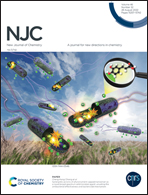N, P co-doping triggered phase transition of MoS2 with enlarged interlayer spacing for efficient hydrogen evolution†
Abstract
Molybdenum disulfide (MoS2)-based transition-metal chalcogenides are considered to be cost-efficient, environmentally-friendly, and stable materials in the application of electrocatalytic hydrogen production. However, the low density and poor reactivity of active sites within the basal plane of MoS2 hinder hydrogen evolution reaction (HER). Herein, we reported that N, P co-doped in the basal plane of MoS2 (N, P-MoS2) can convert the parts of 2H MoS2 to 1T MoS2 and enlarge interlayer spacing for an efficient HER. Subsequently, electrochemical tests revealed that N, P-MoS2 showed an overpotential of 179 mV at 10 mA cm−2, a corresponding Tafel slope of 143 mV dec−1, and remarkable long-term stability over 20 h. In addition, we combined these findings with theoretical results from density functional theory (DFT) simulations. The results confirmed that the synergistic effect of N and P activated the HER catalytic activity at the edge of N-MoS2. In short, the synergy improved the conductivity of N-MoS2 and promoted the rapid transfer of charge to achieve high-performance HER activity. The work provides new insight into the synergistic effect of N and P co-doped in the basal plane of MoS2, as well as a new pathway for the rational design of efficient HER electrocatalysts.



 Please wait while we load your content...
Please wait while we load your content...